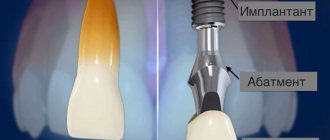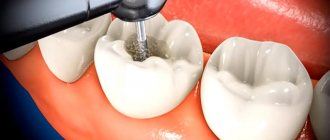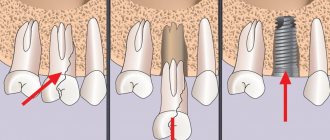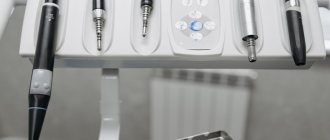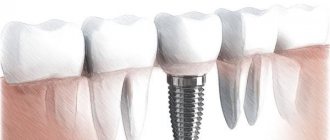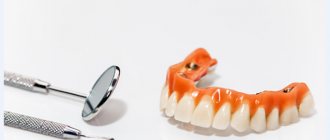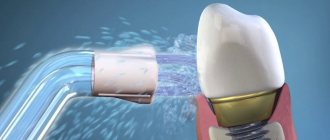Installing a crown on a tooth is one of the prosthetic options used when one or more dental units in a row are lost. Sometimes a dental crown is required even in the absence of a single edentia - for example, if it is necessary to restore the aesthetics of the dentition in the smile area. There are specific indications and contraindications for the procedure, and it is performed in several stages. We will discuss the specifics of the process of installing dental crowns in detail below.
After reading the material, you can find out how to install a crown on a tooth, what types of structures can be used in the procedure, and whether the process will be painful for the patient. We will also separately consider the specifics of removing a dental crown.
Calculate the cost of treatment by taking a short test in 20 seconds!
Do not delay your treatment, because in this matter time plays against us.
Indications for prosthetics by installing dental crowns
There are certain indications for installing a crown on a tooth, as for any other dental procedure. In what cases is prosthetics with dental crowns performed? It would be advisable to carry out the procedure in the following circumstances:
- Significant destruction of dental units by deep caries.
- Traumatic tooth destruction, in which the unit still has healthy roots.
- Aesthetic defects: noticeable discoloration of the enamel coating, chips.
Also, the installation of temporary crowns will be justified in case of periodontitis: the design will prevent further loosening of the teeth and, accordingly, will protect them from falling out. Indications for crown installation are determined during a diagnostic examination. Do you need to get a crown on your tooth? The orthopedists of our dentistry in Moscow - VENSTOM - will help you find the answer to this question! Come see a specialist at any time convenient for you. We are located next to the Baumanskaya metro station, you can walk to the clinic from the metro in just five minutes!
What diet should you follow?
A lot depends on the original condition of the tooth to be restored. So, if the root is strong, approximately half of the tissues of the coronal part are preserved, and the prosthesis itself is installed correctly and professionally, there are no obvious restrictions in terms of load. Stump tabs, which are also used to strengthen the root system, fit very tightly, hold securely and do not require any special changes in nutrition. But if, for example, prosthetics were performed on a pin, the chewing pressure on the tooth must be reduced, since it can lead to displacement of the pin, and subsequently the crown.
In general, recommendations for any type of prosthetics from a nutritional point of view would be as follows:
- limiting the consumption of drinks high in caffeine (tea, coffee) and coloring pigments (wine, beets), especially if you have plastic and metal-plastic crowns that absorb dyes from food and drinks,
- Food that is too cold or too hot should be eaten with great caution - it can lead to cracks and chips of materials, and disruption of their adhesion (fixation). It is also impossible, for example, to immediately drink hot tea after cold ice cream - sudden temperature changes can again provoke the formation of cracks and destruction of dentures, weaken the effect of the fixing adhesive,
- Despite the fairly high strength of crowns and inlays, you need to protect them from excessive loads - it is better to first cut solid food into small pieces,
- teeth with crowns should not be used to open the shells of nuts, such as pistachios,
- If you have dentures, it is recommended to avoid viscous and stringy foods, namely chewing gum and toffees, which can stick to crowns or inlays, and with excessive load and gradual deterioration of the fixation of the prosthesis can lead to its loss.
First of all, crowns that have an external coating that can break off need to be protected from mechanical loads - made of metal-plastic, metal-ceramic or zirconium coated with ceramic.
Does it hurt to put a crown on a tooth?
The question about the pain of installing dental crowns is the most common question among patients. And it should be noted that it is impossible to eliminate 100% discomfort during the procedure - the process of preparing for prosthetics will be most unpleasant for the patient. At this stage, the doctor will drill the teeth to gain access to the canals for their subsequent cleaning and filling.
These manipulations can be quite painful and therefore, to reduce the degree of discomfort, the specialist uses anesthetic drugs. Modern anesthetics completely remove pain, their effect lasts about 3 hours and this time is enough to complete the preparation for prosthetics. The process of installing crowns itself does not cause pain, since the structures are placed on pulpless or, more simply put, dead dental units in which there are no nerve endings.
In our dentistry in Moscow, VENSTOM, dental prosthetics with crowns are carried out using modern anesthetics, which completely eliminate unpleasant and painful sensations during treatment! You can get a detailed consultation on prosthetics by visiting our clinic. We are located next to the Baumanskaya metro station.
Dentist surgeon
One of the most difficult specializations in dentistry is surgery. Doctors perform surgical interventions during the treatment of diseases and help eliminate defects that worsen a person’s appearance. A dental surgeon performs a wide range of services:
- removes teeth;
- treats dislocations of teeth and joints;
- performs jaw surgery;
- eliminates stomatitis, pulpitis, gingivitis;
- neutralizes the infectious process;
- removes the consequences of injuries and congenital defects of the oral cavity.
Often, a prosthetist combines practice with surgical activities.
The surgeon, in tandem with the orthopedist, prepares the jaw for prosthetics, inserts and removes implants.
The main stages of the procedure for installing a dental crown
Installing a crown on a tooth - this procedure is usually divided into several stages, which will be useful to get to know before your initial visit to the dentist. The main stages of the process of placing dental crowns will be discussed in detail below.
First visit to an orthopedic dentist
During the initial appointment, the specialist examines the patient’s oral cavity, prescribing additional tests if necessary. Based on the data obtained, the doctor develops a treatment plan, offering the patient possible options for restoring lost teeth or dentition aesthetics. The treatment plan takes into account not only the need to install a denture, but also additional manipulations, including: Removal of severely damaged and non-viable dental units;
Treatment of the patient’s dental and oral diseases: caries, pulpitis, root canal filling, oral sanitation.
Next, a specific type of dental crown is selected and the cost of turnkey prosthetics is calculated and the timing of its implementation is also determined.
Who does prosthetics and dental implants?
If you are interested in which doctor places dental crowns, then know that this is done by an orthopedist - a doctor of narrow specialization who can combine his function with another dental specialty. Often, a prosthetist combines practice with surgical activities, since the installation of many prostheses requires surgical intervention.
The services of an orthopedic surgeon are in demand to implant an artificial root into the bone, install an abutment and fix a crown on it. Implantation is a serious intervention that requires a comprehensive diagnosis of the mouth. Based on the results, the specialist develops a prosthetic plan and makes impressions for the crown.
Preparing to install dental crowns
Traditionally, crowns are placed on dead (pulpless) teeth, but sometimes there is a need to install a structure on living teeth. This has a positive effect on the final result of prosthetics, since living dental units are stronger and less susceptible to destruction processes, which ensures a long useful life of the crown. Usually, chewing teeth are not depulped during prosthetics. They have a significant area of the natural crown and the distance from the enamel layer to the pulp is greater, which eliminates burns to the natural tissues of the oral cavity during prosthetics.
How do you know when it’s time to change crowns?
Cracks, poor fixation on the tooth, discoloration, discomfort when closing the jaws - all these are reasons to consult a doctor. A crown can fail either after 2-3 years or after 10-15 years - a lot depends on the initial situation, the professionalism of the doctor, the quality of the material, as well as on how the teeth were used. We strongly recommend visiting the dentist 1-2 times a year to examine the oral cavity - the doctor will be able to assess the quality of fixation of the prosthesis and its integrity. This way, you won’t have to guess how long the crowns will last, but will be able to understand exactly when you need to worry about replacing them.
All recommendations boil down to the fact that crowns, inlays and bridges, like living teeth, require regular care and careful treatment. Do not forget that in addition to artificial crowns, living tissues remain in the oral cavity - these are gums and ligaments that hold the root of the tooth. All of them are susceptible to inflammatory processes, which can lead to the loss of the remaining living tooth along with the installed prosthesis.
Free consultation on the cost of treatment in our dentistry
Leave a request and the clinic administrator will contact you within 15 minutes!
For single-rooted dental units, the depulpation process is mandatory, since the risks of thermal burns during grinding are quite high and this is fraught with the future development of an inflammatory process under the crown. Single-rooted teeth are drilled out, the nerve is removed, and the canals are cleaned and filled.
If there are dental diseases - caries, pulpitis, periodontitis - manipulations are performed to treat them. The nerves of the unit are removed, the canals are expanded with a special instrument, filled with gutta-percha, after which a filling is installed on the tooth itself. In case of serious damage to a tooth due to caries, it is important to install a strong filling and provide additional fixation. If this is not done, the dental crown may simply fall out along with a poor-quality filling. The process of restoration of a natural dental crown can be implemented in practice using two methods:
1. Installing a crown on a pin. The pin element is screwed into a pre-filled root canal and the natural coronal part of the tooth is restored at its base. After the filling is made, it is ground down to install the crown.
2. Using a stump insert. This element is manufactured in laboratory conditions and, when installed, is fixed in two areas at once: the dental canal and the area of the natural tooth crown.
These labor-intensive manipulations are carried out exclusively in the presence of serious destruction in the area of the natural dental crown, and if we compare the methods in terms of reliability, then the most high-quality result can be obtained by placing a stump inlay.
Example of a daily diet
It’s easier to eat after dental implantation if you have a cheat sheet - a menu for the day. It should be varied and recommended in the postoperative period. Here is an approximate daily diet:
- Breakfast 1: oatmeal with banana slices, butter. Boiled in milk or water. Warm green tea.
- Breakfast 2: cottage cheese casserole with sour cream. Herbal tea is not hot.
- Lunch 1: vegetable puree soup. Meatballs with mashed potatoes. Uzvar.
- Lunch 2: chicken broth with mashed potatoes. Boiled cauliflower puree, broccoli, steamed meatballs. Pumpkin juice.
- Dinner 1: Steamed fish cutlet with a side dish of rice flakes. Kefir.
- Dinner 2: chicken cutlet with chopped buckwheat porridge. Compote.
- Snacks: any baby food, cereal, fruit puree, yoghurt.
It is important not to starve during the recovery period; always have on hand what you are allowed to eat after dental implantation.
Grinding teeth for crown installation
The professional name for the process of grinding teeth for installation of crowns is preparation, which is performed with a special device - a drill. Using diamond burs, the doctor gives the dental units the shape that will allow the crown to be firmly installed. Grinding can be a rather painful procedure for the patient if dental units that are not previously depulped are subjected to treatment. In this case, local anesthesia is required.
Natural tooth tissue is removed by a specialist to the thickness that the crown will have. On average, up to 2.5 millimeters of dentin can be removed from each side of the unit, depending on the type of crown prosthesis. Cast crowns require minimal grinding of teeth; maximum layers of tissue are removed before installing ceramic and metal-ceramic products. After grinding, a stump base remains from the tooth, on which the prosthetist will subsequently install a crown.
How to insert teeth + video
Before installing crowns, the doctor examines the patient, assesses the condition of the cavity and suggests the best way to solve the problem. Then he identifies contraindications and sends for an x-ray.
- At the beginning of the work, the doctor removes yellow plaque and stone from the enamel, and treats the gums. If the root part of the tooth is not damaged, the nerve is removed, the canals are filled and the teeth are ground for crowns and the upper part to install a prosthesis.
- When preparation is complete, the orthopedic surgeon creates a wax impression from which the crown is created.
- For dentures made of zirconium dioxide and other metal-free materials, instead of an impression, a 3D scan is made and a crown is made that is as close as possible to the tooth tissue.
- The finished prosthesis is tried on the patient. If it does not create any inconvenience and covers the tooth well, it is fixed.
- Sometimes the crown is inserted in two stages. First, fix it temporarily and observe the result for 2 weeks. In the absence of negative symptoms, the crown is permanently attached.
The surgeon, in tandem with the orthopedist, prepares the jaw for prosthetics.
The time the dentist spends on installation depends on the condition of the jaw and the materials used for the prosthesis. On average, work takes 5-10 days. The responsible doctor performs all manipulations under local anesthesia, so the patient does not experience pain and can relax in the dental chair.
Taking impressions and making crowns
An impression is taken of the prepared dental units. For this procedure, a special dental plastic mass is used. An impression is necessary to make an exact plaster copy of the patient’s teeth, which will be used to create a permanent structure. For the production of crowns, different types of materials can be used - metal, metal-ceramics or ceramics. The specific type of raw material is selected based on the characteristics of the case and the wishes of the patient.
The production time for dental crowns depends on the type of material chosen. The production process of ceramic and metal-ceramic products takes the longest. If structures made from these materials are chosen for prosthetics, then temporary dental crowns made of plastic are made for the patient during the period of their manufacture. Temporary crowns will help to recreate the aesthetics of the dentition and, in addition, will protect the ground and weakened teeth from the destructive effects of external factors.
Trying and installing a crown
At the stage of manufacturing crowns, a preliminary fitting is required, which will allow us to evaluate the accuracy of manufacturing structures for the patient’s teeth and the tightness of the product. If all is well, the crown manufacturing process ends, the finished prosthesis is handed over to the orthopedist and the patient is invited to the specialist’s office for preliminary temporary fixation of the structure.
Temporary fixation of the crown is an event necessary to check the quality of the crown installation. The specialist will also evaluate the tightness of the prosthesis to the ground teeth and make sure that the closure of the crown with the opposing teeth occurs correctly. When temporarily fixing dental crowns, permanent cement is not used, and this allows you to quickly remove the structure if any defects are detected during its operation.
The assessment of the quality and convenience of the crown during temporary fixation is carried out within a certain period of time, which on average is 2-4 weeks. If no defects are identified during this time period and the patient does not complain of discomfort, the crown is fixed with heavy-duty permanent cement. This completes the prosthetic process.
Calculate the cost of treatment by taking a short test in 20 seconds!
Do not delay your treatment, because in this matter time plays against us.
What are they: materials
Crowns are made from different materials: some are more durable, others are only suitable as a temporary measure. Their cost, complexity of manufacturing and installation also depend on this.
Metal ceramics
The product has a metal frame and is covered with ceramics on top.
| Pros: | Minuses: |
| High strength. | Contraindicated for people under 18 years of age. |
| Aesthetics. | Not suitable for gum recession. |
Metal-ceramic crowns are suitable for installation only in adult patients.
Metal composite
The crown frame is made of an alloy of chromium and cobalt. From above it is covered with a photopolymer composite: while it is soft, it is given a shape, after which it is fixed with UV rays.
| Pros: | Minuses: |
| High strength. | Coloring from products with pigment. |
| Thin and invisible edges. |
People with metal-composite crowns need to follow a diet to prevent artificial teeth from changing color. It is not recommended to consume drinks with dyes and foods with a high pigment content.
Golden
The oldest material for making crowns is gold.
| Pros: | Minuses: |
| Hypoallergenic. | Lack of aesthetics. |
| They do not damage neighboring healthy teeth. | Rapid abrasion due to the softness of the metal. |
It is best to install gold crowns on the back teeth, where they will be almost invisible.
Zirconium dioxide
Modern material for crowns is zirconium dioxide. It is durable, aesthetic, does not cause allergies and lasts a long time. But it has a fairly high cost, so it’s not suitable for everyone’s budget.
Metal-free
Modern synthetic materials can completely replace metal in the composition of the crown. They are no less durable, and look as close as possible to natural teeth.
Ceramic
The best way to choose the color of a crown is when it is made of ceramic. They do not look artificial, as they are quite transparent.
They are great for replacing incisors. But for chewing teeth, ceramic crowns are too fragile and cannot withstand such a load.
Porcelain
Porcelain crowns are not so popular, but are gradually becoming more and more in demand. They are easily and firmly fixed, which reduces the risk of loosening. Porcelain products last a long time, do not deteriorate due to temperature changes and are not stained by food. In this case, the crown can be made in an anatomical shape, repeating the relief of the tooth as accurately as possible, which ensures comfortable wearing. They look very aesthetically pleasing and are also hypoallergenic.
One of the disadvantages is their loose fit to the tooth, which can cause cervical caries. Crowns are quite fragile and can destroy adjacent healthy teeth. The product is not suitable for patients with thin enamel. In addition, the cost of such crowns is quite high, which is not affordable for everyone.
Combined
By combining several materials, it is possible to create crowns that combine their best properties. The product is suitable for use on front and back teeth: they look aesthetically pleasing and can withstand chewing loads. But such crowns are short-lived because they quickly wear out and sometimes become deformed. But their installation does not cause a blow to the budget.
Plastic
Plastic crowns are used as a temporary measure. They are manufactured on site and installed on the same day in place of the extracted or treated tooth. The cost of such crowns is low. But it is impossible to use them as permanent ones, since they cannot withstand prolonged chewing load.
Removing dental crowns: indications and features of the process
Removing dental crowns is a procedure that becomes necessary if certain complications arise after installing the prosthesis. Removal of the structure may be required in situations:
1. Poor quality preparation for dental crown prosthetics. If the tooth canals are poorly cleaned and poorly sealed, then an inflammatory process may begin to actively develop in them. If such a process occurs, the crown will need to be removed and the tooth treated or removed.
2. Inaccuracies in the manufacture of a crown on a tooth, in which the installed structure will overestimate the bite and not fit tightly to the tooth.
Crowns are also removed for planned replacement. High-quality structures can last up to 10 years or more, but after that the crown will be replaced with a new orthopedic product. Crown removal may be uncomfortable for the patient, so it is usually performed using local anesthesia. To remove the structure, it is sawed with a bur, removed, and those medical manipulations that are necessary for a particular case are performed.
We hope the material helped you learn all the important nuances of installing crowns on your teeth, and you can always get more detailed advice on prosthetics from the dentist at our Vanstom clinic in Moscow! To make an appointment, just call us!
Is it possible to carry out professional hygiene with crowns?
Both teeth and any dentures require high-quality hygiene. Once or twice a year, have your teeth cleaned with an ultrasound. But Air Flow is prohibited in the presence of multiple crowns, since the drug contains abrasive particles that can damage the smooth surface of the dentures. In such a situation, you should definitely warn the doctor about the presence of crowns or bridges - if there are few of them, you can simply bypass them and carry out Air Flow cleaning in another area.
